#taku unami
Explore tagged Tumblr posts
Text
taku unami -- bot (excerpt)
4 notes
·
View notes
Text
Radu Malfatti: trombone
recorded on September 11, 2011 by Taku Unami at AMPLIFY 2011: stones at The Stone in NYC
4 notes
·
View notes
Text

New release coming soon!
recordings from 2017 by Takahiro Kawaguchi, Hong Chulki, Choi Joonyong
recorded by Taku Unami
photo by Lee Hangjun
0 notes
Text

Chance Encounters #001
https://www.mixcloud.com/thomasmartinnutt/
Thomas Martin Nutt, Francesco Fabris and Ben Frost, Taku Unami, Guy Vandromme, Luciana Elizondo, Adriaan Severins, Fabio Gionfrida, Niko-Matti Ahti, Ruth Anderson, The Caretaker, Christian Marclay, Unknown Recordist, Wendy Carlos, William Shatner, Mark Barrott, Denis Dufour, Jaimie Branch, Mabe Fratti, Clint Mansel, Morton Subotnik, Laurie Spiegel, Olivia Block, Kronos Quartet, Jean Luc Godard, Fred Frith, Max Eastley, Graham Halliwell, Evan Parker & Mark Wastell, Ensemble
2 notes
·
View notes
Text
Listed: Al Karpenter

Al Karpenter was originally Álvaro Matilla (from Barakaldo). In 2014, Mattin started to collaborate with him and in 2022, Marta Sainz and Enrique Zaccagnini from Santander joined. They’ve spent the years post-COVID in a fever pitch of noise collaboration, working with fellow experimenters Sunik Kim, Dominic Coles and Triple Negative on their album The Forthcoming and with CIA Debutante on another self-titled disc. Jennifer Kelly reviewed both in August, writing that, “Al Karpenter swamps threads of song in seething banks of noise and dissonance. You find yourself focusing on blaring surface noise, while sense and melody percolates somewhere underneath.” Here Mattin picks ten boundary-pushing favorites.
El Inquilino Comunista — “Cruel Off” (1992)
youtube
This track was actually in their first tape, which for me, was probably the best thing to come out of Getxo Sound, a small noise rock scene that happened in my hometown around the early 1990s. I remember getting this cassette and being blown away. I got inspired to see that there were bands doing things like this in my surroundings. Then I found out about other great bands like Cancer Moon, La Secta, Lord Sickness and Pop Crash Colapso. Now some of the members of El Inquilino Comunista play in other bands like Basurita and Trampas (where my very good friends Piji and Pablo play).
Hanne Boenisch — A Journey to the North Pole: A documentary about the Scratch Orchestra and Cornelius Cardew. (1971)
youtube
This documentary portrays the last tour of the Scratch Orchestra and the heated debates that they were going through, but also it documents the amazing experiments and street concerts that they were doing. After this tour, a split happened between the more Maoist-influenced section called the ideological group around Cardew, John Tilbury and Keith Rowe and the more anarchist and performative tendency that went into forming the Slippery Merchants. The tension between the artistic and ideological parts and their split reminds me of the division that occurred with Situationist International in 1961, in Gothenburg, where all the artists were expelled from the group.
Junko — Sleeping Beauty (2002)
youtube
I heard this record at Taku Unami’s house when I was on tour in Japan for the first time in 2004. I knew Junko from Hijokaidan, but this solo recording really cut through everything that I listened to before. It could be said to be concrete poetry or noise, but for me is something else that takes an existential level. What are we as humans when communication becomes only lubrication for commodification? This is not a form of primal scream but rather an expression of the impossibility of meaningful existence under capitalism.
Parmentier — Luxsound: 5 Untitled (1998)
youtube
Rosy Parlane and Dion Workman formed Parmentier when Thela — the New Zealand noise rock they both had with Dean Roberts — disbanded after a legendarily chaotic concert in New York in 1997. Parlane and Workman left their rock instruments and started an excellent electronic label called Sigma Editions and their band Parmentier. I saw them live in 1999 at the Sprawl in London, and I was so moved by this amazingly precise electronic music but made with a New Zealand noisy attitude which gave it a very warm character. I ended up becoming very good friends with Rosy, Dion and Dean and collaborating with all of them on different occasions.
Constant Pain — Demon Lover
youtube
Another band from New Zealand with Cameron Bain, Greg Cairns and Roddy Pain.
Cameron lived in London and used to play in the bands The Mean Streaks and Heliogabalus with Matthew Hyland (of Triple Negative). Roddy also had a short-lived band called Evil with Liz Matthews and David Mitchel, which was simply incredible. Both Cameron and Roddy took the rock spirit seriously, unfortunately to its ultimate consequences. Noise rock made with love and integrity.
Roberta Settels — “Landscape With 3 Tape-recorders And…” (1985)
youtube
I got this record, Isolation! Meinhof In Memoriam, when I was living in Stockholm, and I thought it was the coolest record ever. Settles self-published it on her label Music in Crisis after Caprice Records — an institutional label part of Musikverket (Swedish Performing Arts Agency) — refused at the last minute to publish it because they were scared of the political message of the record. Some of it reminds me of what the composer Bernhard Günter was doing in the 1990s but without any of the esoteric connotations. For me, this is a great example of how avant-garde music can meet radical politics.
Batile Alake — The Waka Queen
youtube
When Xabier Erkizia and I got to Lagos in 2014 to record Billy Bao’s Lagos Sessions, the first thing that we did was to go to Jazzhole record shop. The owner Kunle Tejuoso started to play us all these amazing records of Sakara, Apala and Waka Music at full volume, and Alake really struck a chord in us. For some reason, later on, Kunle would not tell the name of Alake as if she were some sort of sacred secret. Somehow, we managed to find out who she was, and since then, we have been in love with her.
Petrona Martinez — Le bullerengue (1998)
youtube
After that experience in Lagos, I have been searching for similar sounds that focus on percussion and voice in other places by tracing Afro-Caribbean music. The first thing that I got into it was Cuban rumba, especially Muñequitos de Matanzas. A couple of years ago, I was hearing a DJ session of Amuleto Manuela, an incredible Colombian DJ based in Berlin, and she played Petrona Martinez which is bullerengue from Colombia, and this got me into similar forms of music like Puerto Rican Bomba of el tambor from Venezuela.
Gérard Lockel — Gwo Ka Modènn (A.D.G.K.M - 1988)
youtube
Another interesting musical genre from the Caribbean is Gwo Ka from Guadalupe.
I discovered Gérard Lockel when I was researching Bèlènou, a fascinating group from Martinique mixing traditional Bèlè with avant-garde approaches. Bèlènou was founded by Edmond Mondésir and Léon Bertide, and I read that they were influenced by Gérard Lockel, so I went to the source, and it was life-altering. I quickly found out that I was not the only one deeply touched by his music, his records cost between 300 and 600 euros on Discogs.
Elvin Brandhi — Shelf Life (2019)
youtube
My friend Miguel Prado mentioned Elvin Brandhi, and she is doing some of the best stuff that I heard lately. She is collaborating with incredible artists and travelling all the time. A noise nomad and a fantastic improviser. The first time that I saw her was with Yeah You — the group that she has with her father — at an empty shopping mall in Glasgow as part of the extraordinary Counterflows festival, and it was magnificent. As far as I know, this is her only solo record.
#dusted magazine#listed#al karpenter#mattin#El Inquilino Comunista#Hanne Boenisch#cornelius cardew#scratch orchestra#junko#parmentier#constant pain#roberta settels#batile alake#petrona martinez#gérard lockel#elvin brandhi#Youtube
3 notes
·
View notes
Text
A non-peculiar Spectre
My new album is out today on the Skörd label!
The music is a mixture of free improvised, prepared guitar a la Keith Rowe, and field recording collages. Taku Unami has been a big influence on how I’ve worked with material.
The album is free for streaming or download!
https://skord.bandcamp.com/album/a-non-peculiar-spectre

#music#experimental music#abstract music#eai#field recording#sound collage#guitar#electric guitar#new music#contemporary music#collage#collage music#indeterminacy#skörd#bandcamp
2 notes
·
View notes
Text
Watashitachi

1 わたしたち
2 Arc
3 ヘッドライト
4 Iceberg
5 Estrela Cadente
6 Instruments
7 Stain
8 ドア
9 Andromeda Strain
Thieves
大藏雅彦 masahiko okura | vocal, electric bass, etc
遠藤ふみ fumi endo | piano, vocal
阿部真武 masatake abe | electric bass
all songs written by masahiko okura
recorded and mastered by taku unami
mixed by masahiko okura
1 note
·
View note
Text

【Release Info】 Various [monooto: Object-Oriented Music in Japan] (ato.archives / November 15, 2024) - Cassette / Digital
ato.archives Bandcamp Page Leo Okagawa Bandcamp Page: TBA
[Tracklist]
Tetsuya Nakayama - "Minoru"
Masami Tada - "Katakata"
Shuta Hiraki - "Kara no Kazaana"
Masahiro Sugaya - "鳴ってしまう / It Sounds"
yasuhito suzuki - "Monotone"
S. Grey - "Aprilled"
Natsumi Nogawa - "Flower Pods"
Masayuki Imanishi - "Deck"
Leo Okagawa - "Hz"
sorta opalka - "ObjectO"
Mastering: Taku Unami Cover Art: Steven van Lummel Layout Design: Graphic Potato Text on the tape sleeve: Motoaki Iimori (Philosopher/Contemporary metaphysics) Translation: Chiara Comastri Project Creation & Release: ato.archives Special Thanks: Leo Okagawa and Shuta Hiraki (for their great essay on monooto)
Excerpt from the text on the tape sleeve by Motoaki Iimori (Philosopher)
-Monooto represents a genuine encounter with objects. The whispers of countless items draw us into an unfamiliar realm, directing our ears toward the shadows where they reside. This is the emerging music genre known as “monooto”.
-Interestingly, the Japanese term “mono” (もの), meaning “thing” or “object,” carries a subtle eeriness. According to the Nihon Kokugo Daijiten, “mono” can also denote deities, spirits, or objects of fear and reverence, including ghosts and vengeful spirits. Terms like "mononoke" (vengeful spirit or monster) reflect this notion of “mono” as entities that transcend our understanding.
テープスリーブに掲載された飯盛元章(哲学者)のテクストからの引用
-monootoとは、物との真の遭遇である。 無数の物どものざわめき。未知の空間へとわたしたちを引きずり込み、物どもが潜む闇のほうへとわたしたちの耳を向けなおさせるサウンド。それが、現在生まれつつある音楽ジャンルmonootoだ。
-ところで、「もの」という和語には、漠然とした不気味さがまとわりつく。『日本国語大辞典』によれば、「もの」には「神仏、妖怪、怨霊など、恐怖・畏怖の対象」という意味がある。「もののけ」といった言葉もある。わたしたちは、理解を越えた不気味な存在を「もの」と呼ぶわけだ。
0 notes
Text
Mark Vernon's on the concept behind post-chance, a collaboration with Marc Baron:
"The initial idea was that this collaboration should reflect a dialogue between two artists who have not yet met and that it should express something about the gulf between them, both literally and metaphorically. In the exchange of materials and ideas something is inevitably lost along the way – whether it be misunderstandings due to interpretation, language, slippage of meaning or simply things going astray. From the outset we decided to make a feature out of what might be lost in this interchange due to physical distance and the passage of time, and to devise a process that would make this evident.
Sending batches of unspooled quarter inch tape to each other in the post we made the decision to include a magnet in the package that, over the time it took for it to be delivered, would randomly erase parts of the tapes that it came into close proximity with. Each fragment of tape included a self-determined sound miniature – a short audio sketch or recording experiment. Over the course of a year we accrued heaps of these degraded, partially eroded tape fragments. We would each make a copy of the tapes prior to sending, and on receiving them weeks later the other would decrypt what remained of the sounds at the other end, playing back and recording the tapes digitally.
To further open the process up to chance it was decided that whatever minute past the hour the tape was recorded at would be noted and that in the final arrangement of materials it would appear at that exact point within an hour-long timeline. In the compositional stage the changes in state between the original recording and its degraded ‘ghost’ counterpart were highlighted through extreme stereo separation and hard panning. The bringing together of these fragments on the timeline to mix and arrange the piece was also the first time we met in person after a year of this remote sound correspondence. Up until this point, neither of us had any clue about how these elements would sit together, whether the juxtapositions would work or not, whether the process would bear fruit or turn out to be a complete disaster."
released February 1, 2024
Marc Baron / Mark Vernon - post-chance (Erstwhile 097)
recorded by Marc Baron and Mark Vernon between June 2022 and October 2023 mastered by Taku Unami produced by Jon Abbey
front and back cover images by David Fulford inside panel image by Mark Vernon layout by Yuko Zama
p+c 2023 Erstwhile Records www.erstwhilerecords.com
0 notes
Text
new album "Sun Plaza" out now
Thanks to Taku Unami and Hong Chulki.
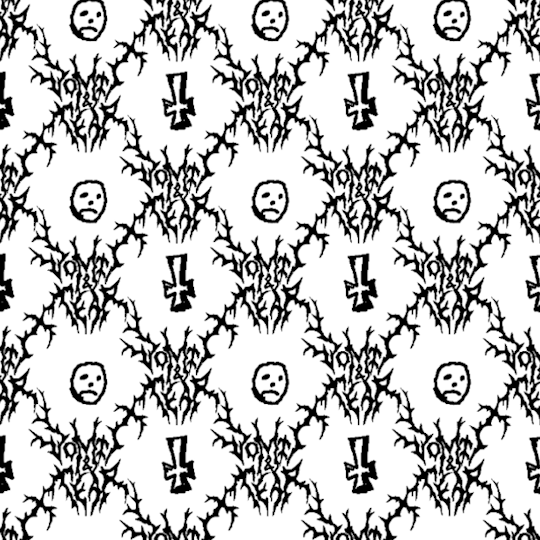
1 note
·
View note
Text

THEODORA KATZ 1st album "HENRY'S POCKET" release💐 theodora katz by me. now bandcamp only. all songs written and performed by maho iitani #6 drums by kazuki ubukata(from ieha) #8 drums by kurumi kadoya(from HYPER GAL) #1,#2,#4,#5,#7,#8 mixed by maho iitani #3,#6 mixed by maho iitani and yuji sakatani masterd by taku unami thank you💟
1 note
·
View note
Text
Keith Rowe: guitar, electronics
recorded on September 11, 2011 by Taku Unami at AMPLIFY 2011: stones at The Stone in NYC
1 note
·
View note
Photo
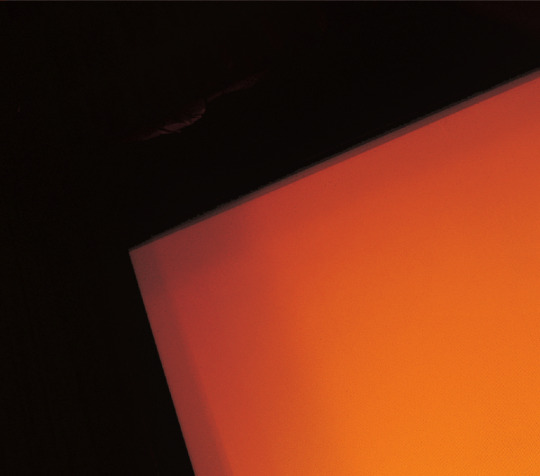
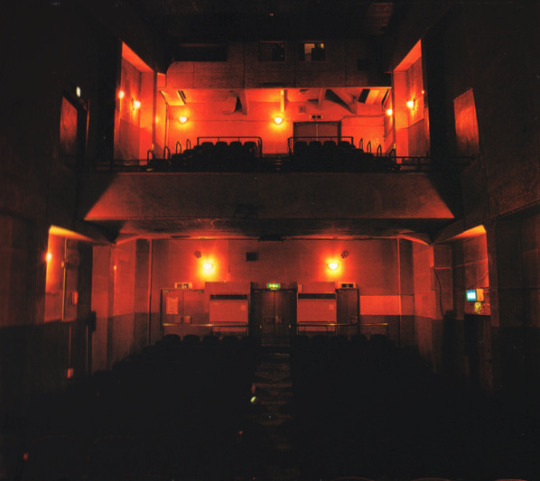

Taku Unami & Takahiro Kawaguchi - Teatro Assente
Erstwhile Records
2011
#Taku Unami#Takahiro Kawaguchi#Teatro Assente#Erstwhile Records#2011#album art#abstract#free improvisation
58 notes
·
View notes
Text
Rope Editions presents: Negative Space at THIRD HAND
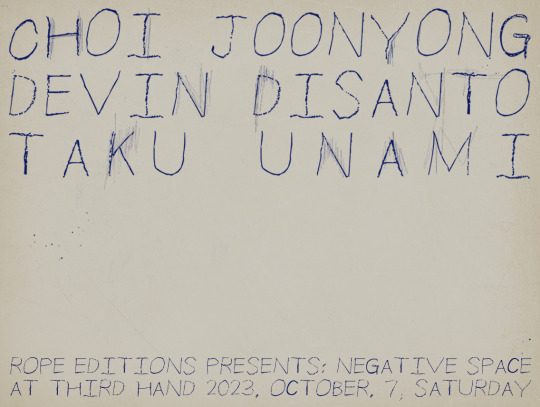
https://www.instagram.com/ropeeditions/
10월 7일 토요일 연희동에 위치한 목공 스튜디오 THIRD HAND에서 공연을 기획합니다. 이번 공연은 내년에 미국 뉴저지 기반의 Erstwhile Records 에서 발매될 최준용 / 데빈 디산토의 앨범 녹음을 준비하기 위한 자리이기도 하며, 스페셜 게스트로 일본의 타쿠 우나미가 함께 합니다. 데빈 디산토는 작년 로프 에디션스의 음반에도 참여했었던 만큼 이번 공연이 더욱 뜻 깊은 자리가 되지 않을까 싶습니다. 수용 가능한 인원에 제한이 있어 티켓은 사전 예매로만 진행 할 예정입니다. 참석을 원하시는 분들은 프로필에 표기된 구글 폼을 통해 신청서를 제작해 주세요. 연주 중 소음을 유발할 수 있는 핸드폰이나 카메라 사용을 자제할 것을 부탁드립니다.
Rope Editions presents: Negative Space at THIRD HAND (Third Hand_Seoul)
⌁ Choi Joonyong ⌁ Devin DiSanto ⌁ Taku Unami ⌑ 티켓: 사전 예매 25,000원 (현매 X) ⌑ 일자: 2023년 10월 7일 오후 8시 ⌑ 장소: 서울시 서대문구 홍연길 87 지하 1층
1 note
·
View note
Photo

David Grubbs & Taku Unami - Comet Meta
Like me, you probably know David Grubbs from his pioneering work with Squirrel Bait, Bastro and Gastr del Sol, not to mention his long, varied solo career. Japanese musician Taku Unami, on the other hand, is new to these ears — though judging from his Discogs page, he’s got a similarly vast catalogue to explore. Regardless of their respective backgrounds, this Comet Meta collab is a total delight, with the pair’s crystalline guitars melting together on the lengthy title track or Grubbs’ moody piano drifting over Unami’s soundscapes on “Mirror Auction at Echo Door.” Like much of Grubbs’ previous work, this is understated stuff that encourages deep listening — brainy and quizzical at times, perhaps, but with a friendly undercurrent running throughout. Check it out ...
3 notes
·
View notes
Text
Toshiya Tsunoda / Taku Unami — Wovenland 2 (Erstwhile)
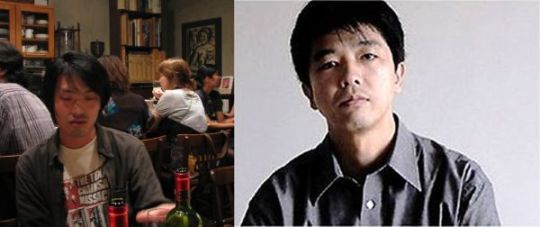
Wovenland 2 by Toshiya Tsunoda/Taku Unami
The first words of Toshiya Tsunoda and Taku Unami’s liner notes to the double CD under consideration here are, “Wovenland became a band.” It should be noted that Wovenland was the name of an earlier album by Tsunoda and Unami, the digipak’s spine still credits this recording to the two individuals. And while it is within Unami’s skill set to pick up a guitar and play a song, nothing like that happens on Wovenland 2. The notes continue: “Our band activities are mainly editing in a studio. Our goal is to focus on acoustic experiments. No more and no less.”
What makes this a band is an overlap of aesthetics and intentions. Both Tsunoda and Unami employ field recordings, and each is quite mindful of the influence that different recording choices exert upon the sound being recorded. But neither treats these concerns as ends. Tsunoda captures essences of place; Unami, who also plays packing materials, synthesizer and guitar in other settings, invites the audience to be aware that they are directing attention to something. Their first recording presented, according to Dusted’s Marc Medwin, “jump-cut juxtapositions of environmental conglomerations, or inter-weavings… with location recordings overlayed or subjected to more radical manipulations.” In other words, the sounds of unrelated places and things were woven together.
But now that they’re a band, they’ve focused their investigation on the interactions between accurately captured sounds and the human processes that interpret and distort them. The first disc, subtitled Mad Patissier, runs similar inputs through related but contrasting processes. The first two tracks, for example, take the same recording of a fishing spot and runs it through a series of analyses. The variables include changes in sound, who often that change is measured and outputted, and who frequently the output was split into three layers. Maybe your band talks about who gets to solo when; apparently, these guys discuss what numbers go into the equation. Depending what numbers Unami and Tsunoda select, the same source material might reveal pigeons in a birdhouse, or a fine spray of gray noise. A recording of a public event might reveal crowd sounds, or the loudest part of firework explosions.
The second disc, entitled Speed Freak, captures the band in boys-will-be-boys mode. Readers who grew up with turntables will likely recall the hilarity that ensued when they and their friends started playing records at the wrong speed. Well, imagine the possibilities when you’re working with digital recordings and playback technology. They did. What if you take those fireworks and run them at 64 times the original speed? What happens if you double that? What do you get when you slow down a recording of cicadas grinding out their night songs? These questions are all premises for individual tracks, but the results are not as academic as you might expect. For just as a good song-oriented band doesn’t just play any song any old way if it wants to keep making records, Unami and Tsunoda have only shared the cool sounds on Wovenland 2. It turns out that slowed-down crickets are pretty hypnotic, and that fireworks played at 128 times their original speed still deliver a jolt.
Bill Meyer
#Toshiya Tsunoda#Taku Unami#wovenland#erstwhile#bill meyer#albumreview#dusted magazine#experimental#electro-acoustic music#field recordings
2 notes
·
View notes